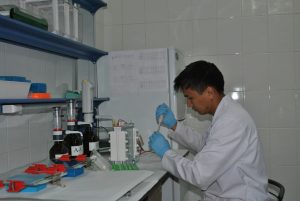AP08857430 “Identification of a new minimally invasive microRNA-based biomarker for the diagnosis and prognosis of diabetic retinopathy”. Scientific supervisor – Sharipov K.O., Doctor of biological sciences, professor.
Project description
Diabetic retinopathy (DR) is a microvascular complication of diabetes mellitus (DM), which is the main cause of irreversible blindness. Due to the difficulties in diagnosing DR (asymptomatic onset, ambiguous early diagnosis, high qualification requirements for a doctor, etc.), there is a need to develop new reliable methods for diagnosing and prognosticating the disease. MicroRNAs are promising biomarkers for many diseases for many reasons (possibility of control in biofluids, i.e., by a minimally invasive method, high stability, etc.). The project will search for an association between the concentration of circulating microRNA and DR in the Kazakhstan population to develop biomarkers for predicting the development of DR, early diagnosis without clinically visible symptoms, predicting possible complications and sensitivity to treatment.

Project goal:
- To determine the diagnostic and prognostic value of circulating microRNAs in diabetic retinopathy.
Project objectives;
- Collection formation of plasma samples from diabetic patients with and without retinopathy. Plasma samples will be used as the object of study. It is planned to collect 200 plasma samples: 100 from DM patients with DR, 100 from DM patients without DR (control group).
- Optimization of the technique for isolating microRNAs from plasma, optimization of reverse transcription and quantitative PCR, optimization of the technique for normalizing quantitative data, selection of reference controls. Plasma is a “difficult” object; the efficiency of RNA extraction can be affected by the lipid-protein composition of plasma, which depends on individual characteristics and the disease. The choice of the optimal normalization technique is one of the key steps in quantitative data analysis. According to common practice, the stability of the expression of endogenous reference controls selected from the literature must be confirmed in the study sample. Problem solution indicators: Ct – not less than 35 cycles; the spread of values in three repetitions is less than 0.5 cycles; PCR efficiency – from 90 to 105%, with R2 in the range of 0.98-1.
- Screening of miRNAs’ candidate on a test group. MicroRNA markers detection will be carried out in two stages. At the first screening stage, 25-30 miRNAs candidate (selected according to literature data) will be tested on a sample of 45 plasma samples (30 patients with DR and 15 patients without DR).
- Validation of potential microRNA markers on an extended sample. At the second validation stage, microRNA markers that showed association with DR will be tested on a sample of 200 plasma samples (100 patients with DR and 100 patients without DR).
- MicroRNA markers’ diagnostic value An assessment will be made of the ability of markers to distinguish patients with complications of DR from patients without DR, including those without clinically visible signs, and by clinical and pathological parameters.
- MicroRNA markers’ prognostic value d The ability of markers to predict the development of DR in patients with DM, the effectiveness of therapy, and complications of the disease will be assessed.
Intermediate results:
- A collection of 100 plasma samples from diabetic patients with diabetic retinopathy, 100 plasma samples from diabetic patients without diabetic retinopathy, and 31 plasma samples from practically healthy individuals (control group) was formed. The assignment was completed.
- The technique for isolating microRNAs from plasma was optimized, the reverse transcription and quantitative PCR reactions were optimized, the method for normalizing quantitative data was optimized, and reference controls were selected. The assignment was completed.
- Candidate microRNA markers were screened on the test group, as a result of which 9 microRNAs were selected for the validation stage. The assignment was completed.
- Work has begun on validating the results of the screening stage on an expanded sample. The work on the assignment is ongoing.
The planned scope of work, according to the Schedule, was completed in full.
Project executors:
- Kamalidin Sharipov, Doctor of Science, professor, Scientific supervisor, Chief researcher. Hirsch index – 3. ORCID ID: 0000-0001-5946-5521; Web of Science ID: AAP-5300-2020; Scopus ID: 57195075321.
- Eldar Ashirbekov, Acting Head of the laboratory, responsible executive. Hirsch index – 2. ORCID ID: 0000-0002-2265-9717; Web of Science ID: E-2115-2015; Scopus ID: 39960967900.
- Aizhan Magazova, researcher, responsible executive, Ph.D. student.
- Arman Abayldaev, junior researcher, executor. Hirsch index – 2. ORCID ID: 0000-0002-1813-1338; Web of Science ID: AAP-1468-2020; Scopus ID: 57204938318.
- Alzhanuly Bakhytzhan, junior researcher, executor, Ph.D. Web of Science ID: X-8740-2018.
- Satken Kantemir Serikbolyly, technician, executor.
 Каз
Каз Рус
Рус Eng
Eng